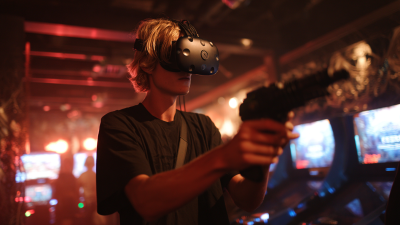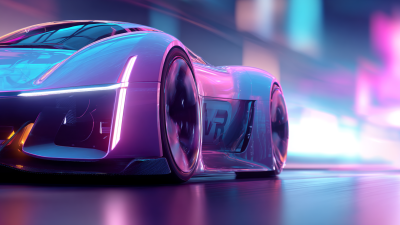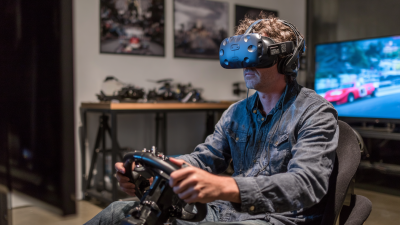5 Key Metrics and Tips to Choose the Perfect VR Racing Car for Your Global Market Needs
Table of Contents
- Identifying the Essential VR Racing Car Features for Market Compatibility
- Understanding Target Demographics for Optimal VR Racing Car Design
- Analyzing Performance Metrics: Speed, Handling, and Realism in VR Racing
- Incorporating Feedback: How Player Preferences Shape Chosen Features
- Evaluating Cost vs. Value: Budgeting for Maximum Impact in VR Racing Cars
- Future Trends: Adapting VR Racing Cars for Emerging Market Demands
- FAQS
- Conclusion
- Related Posts
In recent years, the virtual reality (VR) industry has witnessed exponential growth, particularly in the realm of VR racing car simulations. According to a report by ResearchAndMarkets, the global VR gaming market is expected to reach $45.09 billion by 2026, driven by advancements in technology and increasing consumer demand for immersive experiences.
As one of the earliest VR simulator manufacturers in China, Guangzhou Longcheng Electronic Co., Ltd., VART VR, is at the forefront of this revolution, covering an impressive 8000 square meters and employing over 60 dedicated staff.
As businesses look to tap into this dynamic market, understanding key metrics and tips for selecting the perfect VR racing car becomes paramount. This blog will explore these essential factors to help companies meet their global market needs effectively.

Identifying the Essential VR Racing Car Features for Market Compatibility
When selecting the perfect VR racing car for your global market needs, it's essential to identify the key features that ensure market compatibility. One of the foremost metrics to consider is the visual and gameplay quality. As advancements in VR technology continue to enhance user experience, it is crucial that the racing car model you choose offers stunning visuals and immersive gameplay that can attract a broader audience. For instance, a game that blends intuitive arcade-style gameplay with high-quality graphics is more likely to resonate with players across different regions.

Another important factor is the compatibility of the racing car with various VR headsets and accessories. With multiple options available in the market, ensuring your VR racing car integrates seamlessly with popular headsets, along with offering support for an array of racing wheels, can significantly expand its reach. This integration not only enhances the gameplay experience but also allows players to tailor their setups based on budget and preferences, making it easier for your product to find its niche within various markets. By focusing on these essential features, you can position your VR racing car to meet the diverse needs of players around the globe.
Understanding Target Demographics for Optimal VR Racing Car Design
When designing the perfect VR racing car for a global market, understanding target demographics is crucial. According to a report by Statista, the global virtual reality market is projected to reach approximately $44.7 billion by 2024, with gaming and entertainment accounting for a significant portion of this growth. This highlights the importance of tailoring VR racing car designs to specific user profiles.
Additionally, insights from the International Game Developers Association suggest that 77% of game developers believe inclusive design can enhance user experience. This means that considering diverse racing styles, vehicle modes, and customization options can attract a broader audience.
Understanding preferences based on geography further influences design. For instance, while European players may favor technical tracks that challenge precision driving, North American gamers often gravitate towards high-speed racing experiences. By aligning product features with the specific interests of these target demographics, companies can develop VR racing cars that resonate deeply with users globally.
Analyzing Performance Metrics: Speed, Handling, and Realism in VR Racing
When choosing the perfect VR racing car, analyzing performance metrics such as speed, handling, and realism is crucial to meet global market needs. Recent advancements in VR technology, such as eye-tracking capabilities, have significantly enhanced user interaction with racing simulations. A meta-analysis indicates that deliberate practice may only account for 18% of a racer's performance, underscoring the importance of high-quality simulation tools in honing driving skills (Macnamara et al.). Moreover, the integration of real-time analytics, as seen in recent Formula 1 statistics, provides valuable insights into car performance, allowing for more informed choices in AI-driven racing simulations.
Additionally, the hardware underpinning these experiences plays a pivotal role in performance metrics. The latest graphics cards are designed to handle more complex simulations, and evaluations suggest that the improvements in visual fidelity lead to a more immersive racing experience. As noted in performance discussions, the right CPU and GPU combination will not only enhance speed and rendering but also increase realism through better physics modeling in the virtual environment. The evolution of hardware and software continues to shape VR racing, ensuring that enthusiasts have the tools they need to engage deeply with their racing passions.
Incorporating Feedback: How Player Preferences Shape Chosen Features
In the rapidly evolving landscape of VR racing, understanding player preferences is crucial for developers aiming to refine their products. A recent report from VR Insights indicates that 62% of gamers favor realistic physics and dynamic environments, emphasizing the importance of incorporating authentic driving mechanics into VR racing experiences. This insight underscores a potential competitive edge for developers who listen closely to their audience's desires, aligning features with the growing demand for immersive realism.

To better cater to player preferences, developers should prioritize gathering feedback through beta testing phases. This not only helps in identifying essential features but also engages the community, fostering a loyal user base. For instance, implementing a feedback loop where players can suggest improvements could enhance user satisfaction and increase retention rates by over 30%, according to a study by Gamer Analytics.
Furthermore, integrating multiplayer capabilities is a significant factor noted in recent market research. Approximately 48% of VR racing enthusiasts prefer competitive online settings. For developers, this indicates that investing in robust multiplayer functionality could lead to greater player engagement and overall success in the global market. Focus on refining these aspects will ensure that the final product resonates with the target audience and meets their expectations effectively.
Evaluating Cost vs. Value: Budgeting for Maximum Impact in VR Racing Cars
When venturing into the thriving market of VR racing cars, evaluating the balance between cost and value is crucial. Industry reports suggest that the global VR market is projected to reach $57.55 billion by 2027, showcasing a compound annual growth rate (CAGR) of 44.7% from 2020. As the demand for immersive experiences grows, understanding how to budget effectively can drive significant returns on investment.
To optimize your budget, consider both upfront costs and long-term value. High-quality VR racing cars often come with a higher price tag due to advanced technology and superior user experience. A recent study indicated that consumers are willing to pay up to 30% more for systems that offer realism and performance, emphasizing the necessity of investing in quality. Additionally, efficient allocation of resources towards features like haptic feedback and realistic track environments can enhance engagement and retention, ultimately resulting in higher user satisfaction and increased revenue. Balancing these factors will empower you to make informed decisions that maximize impact in a competitive global market.
Evaluating Cost vs. Value in VR Racing Cars
Future Trends: Adapting VR Racing Cars for Emerging Market Demands
As the automotive industry continues to innovate, the integration of virtual reality (VR) in racing cars is becoming essential to meet the demands of emerging global markets. With technology reshaping practices, the potential of VR racing cars is expanding, offering an interactive experience that aligns with the latest trends in digital gaming and consumer engagement. A recent report forecasts that the in-car gaming market will escalate significantly, transforming vehicles into gaming hubs. This phenomenon underlines the importance of understanding regional preferences and technological readiness when adapting VR racing cars for different markets.
To effectively cater to these emerging demands, manufacturers should consider these tips: First, assess the local gaming culture and digital infrastructure in target markets to ensure optimal user experiences. Second, leverage AI technologies to create personalized racing experiences, enhancing user engagement and enjoyment. Finally, continuously monitor market trends and consumer feedback to iterate on design and functionality, ensuring that offerings remain relevant and competitive in a rapidly evolving space. As the global race for innovation continues, aligning product development with market insights will be paramount for success.
5 Key Metrics and Tips to Choose the Perfect VR Racing Car for Your Global Market Needs
| Metric | Importance Level (1-5) | Current Trend | Future Outlook |
|---|---|---|---|
| Realism of Driving Simulation | 5 | High immersion technology is trending | Continued investment in AI for realistic simulations |
| Hardware Compatibility | 4 | Growing number of compatible devices | Focus on cross-platform capabilities |
| User Engagement Features | 5 | Increased community-driven content | Innovations in social experiences are emerging |
| Data Analytics for Performance | 4 | Usage of big data analytics is on the rise | More tailored experiences through data insights |
| Cost-effectiveness | 3 | Affordable models are being introduced | Growing demand for budget-friendly options |
FAQS
: The key features include visual and gameplay quality, compatibility with various VR headsets and accessories, and the ability to deliver immersive experiences that can appeal to a broader audience.
Visual and gameplay quality are crucial as advancements in VR technology enhance user experience, making high-quality graphics combined with intuitive gameplay essential for attracting players across different regions.
Compatibility allows the VR racing car to integrate seamlessly with popular headsets and support various racing wheels, which expands its reach and appeals to players who wish to customize their setups.
Manufacturers should focus on integrating VR with automotive innovations, understanding regional preferences, leveraging AI for personalized experiences, and monitoring market trends for design and functionality improvements.
By evaluating the local gaming culture and digital infrastructure in target markets, manufacturers can ensure they create optimal user experiences tailored to specific regional needs and preferences.
AI technologies can be utilized to create personalized racing experiences, which enhances user engagement and enjoyment, making the product more appealing to consumers.
Continuously monitoring consumer feedback allows manufacturers to iterate on design and functionality, ensuring that their offerings remain relevant and competitive in a fast-changing marketplace.
The growth of the in-car gaming market indicates a shift towards transforming vehicles into gaming hubs, highlighting the importance of aligning VR racing cars with emerging consumer engagement trends.
Manufacturers should assess market trends, leverage technology for personalization, and adapt designs based on consumer insights to remain competitive and relevant.
Understanding technological readiness ensures that the VR racing cars can be effectively integrated and utilized within specific markets, maximizing their potential for success.
Conclusion
In today's competitive global market, selecting the perfect VR racing car involves a comprehensive understanding of several key metrics. Essential features for market compatibility must be identified, ensuring that the design aligns with the preferences and behaviors of target demographics. Performance metrics such as speed, handling, and realism play a crucial role in creating an engaging experience for users, while player feedback should continuously inform design choices to enhance satisfaction.
Moreover, evaluating the cost versus value is vital to maximize impact within various market segments, particularly for manufacturers like Guangzhou Longcheng Electronic Co., Ltd. VART VR, a frontrunner in the VR simulator industry. By staying attuned to future trends and emerging market demands, companies can effectively adapt their VR racing cars, ensuring they meet the evolving expectations of consumers everywhere.
Related Posts
-

From China's Leading Factory The Trusted Source for the Best VR Race Game Globally
-

Exploring Real World Applications of the Best VR Play Park in Entertainment and Education Industries
-

What Makes VR Arcades a Revolutionary Experience in Entertainment
-

Exploring the Evolution of Vr Car Technology and Its Impact on the Future
-

The Future of Gaming Experiences with VR Simulators
-

Understanding Challenges Faced by Users of Vr Equipment in Various Industries

